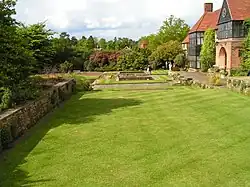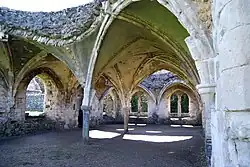Portal:Surrey
| WikiProject Surrey |
The Surrey Portal
Surrey (/ˈsʌri/) is a ceremonial county in South East England. It is bordered by Greater London to the northeast, Kent to the east, East and West Sussex to the south, and Hampshire and Berkshire to the west. The largest settlement is Woking.
The county has an area of 1,663 km2 (642 square miles) and a population of 1,214,540. Much of the north of the county forms part of the Greater London Built-up Area, which includes the suburbs within the M25 motorway as well as Woking (103,900), Guildford (77,057), and Leatherhead (32,522). The west of the county contains part of built-up area which includes Camberley, Farnham, and Frimley and which extends into Hampshire and Berkshire. The south of the county is rural, and its largest settlements are Horley (22,693) and Godalming (22,689). For local government purposes Surrey is a non-metropolitan county with eleven districts. The county historically included much of south-west Greater London but excluded what is now the borough of Spelthorne, which was part of Middlesex. It is one of the home counties.
The defining geographical feature of the county is the North Downs, a chalk escarpment which runs from the south-west to north-east and divides the densely populated north from the more rural south; it is pierced by the rivers Wey and Mole, both tributaries of the Thames. The north of the county is a lowland, part of the Thames basin. The south-east is part of the Weald, and the south-west contains the Surrey Hills and Thursley, Hankley and Frensham Commons, an extensive area of heath. The county has the densest woodland cover in England, at 22.4 per cent. (Full article...)
Selected article
Staines-upon-Thames, commonly known simply as Staines, is a market town in northwest Surrey, England, around 17 miles (28 kilometres) west of central London. It is in the Borough of Spelthorne, at the confluence of the River Thames and Colne. Historically part of Middlesex, the town was transferred to Surrey in 1965. Staines is close to Heathrow Airport and is linked to the national motorway network by the M25 and M3. The town is part of the Greater London Built-up Area.
The earliest evidence of human activity in the area is from the Paleolithic and, during the Neolithic, there was a causewayed enclosure on Staines Moor. The first bridge across the Thames at Staines is thought to have been built by the Romans and there was a settlement in the area around the modern High Street by the end of the 1st century CE. Throughout the Middle Ages, Staines was primarily an agricultural settlement and was held by Westminster Abbey. The first surviving record of a market is from 1218, but one may have taken place near St Mary's Church in the Anglo-Saxon period.
The industrialisation of Staines began in the mid-17th century when Thomas Ashby established a brewery in the town. Improvements to the local transport network in the mid-19th century also stimulated an expansion of the local population. The current Staines Bridge, designed by George Rennie, was opened in 1832 by William IV and the first railway line through Staines opened in 1848. The town became a centre for linoleum manufacture in 1864, when Frederick Walton established a factory on the site of the 13th-century Hale Mill.
At the end of the 20th century, Staines became infamous as the home town of the fictional film and television character, Ali G. Although many local residents felt that the town's reputation was suffering through its association with the character, Sacha Baron Cohen, the creator of Ali G, praised Staines for being a "lovely, leafy, middle-class suburb... where swans swim under the beautiful bridge". Partly in response to the reaction to the character, Spelthorne Borough Council voted in 2011 to add the suffix "upon-Thames" to the official name of the town. (Full article...)
Selected images
Selected biography
.jpg)
Mary Toft (née Denyer; baptised 21 February 1703 – January 1763), also spelled Tofts, was an English woman from Godalming, Surrey, who in 1726 became the subject of considerable controversy when she tricked doctors into believing that she had given birth to rabbits.
In 1726, Toft became pregnant, but following her reported fascination with the sighting of a rabbit, she miscarried. Her claim to have given birth to various animal parts prompted the arrival of John Howard, a local surgeon, who investigated the matter. He delivered several pieces of animal flesh and duly notified other prominent physicians, which brought the case to the attention of Nathaniel St. André, surgeon to the Royal Household of King George I. St. André concluded that Toft's case was genuine but the king also sent surgeon Cyriacus Ahlers, who remained sceptical. By then quite famous, Toft was brought to London where she was studied in detail; under intense scrutiny and producing no more rabbits she confessed to the hoax, which was put upon by her family and was subsequently imprisoned as a fraud.
The resultant public mockery created panic within the medical profession and ruined the careers of several prominent surgeons. The affair was satirised on many occasions, not least by the pictorial satirist and social critic William Hogarth, who was notably critical of the medical profession's gullibility. Toft was eventually released without charge and returned home. The scandal had a lasting effect on public trust in the medical field, contributing to widespread scepticism about the competence and ethics of physicians during that era. (Full article...)
Things you can do
 |
Here are some tasks awaiting attention:
|
- –When a task is completed, please remove it from the list.
Did you know
Subcategories

WikiProjects

- WikiProject Surrey
- WikiProject Woking
Related portals
Topics
|
Associated Wikimedia
The following Wikimedia Foundation sister projects provide more on this subject:
-
Commons
Free media repository -
Wikibooks
Free textbooks and manuals -
Wikidata
Free knowledge base -
Wikinews
Free-content news -
Wikiquote
Collection of quotations -
Wikisource
Free-content library -
Wikiversity
Free learning tools -
Wikivoyage
Free travel guide -
Wiktionary
Dictionary and thesaurus
| WikiProject Surrey Navigation | |
|---|---|
| Main page | Collaboration | | |
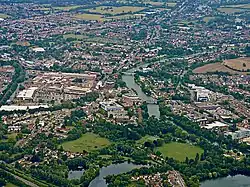






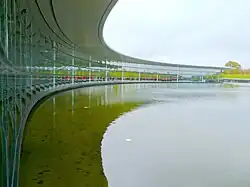





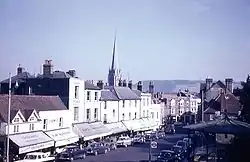
.jpg)
